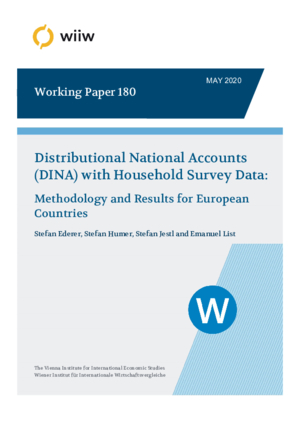Distributional National Accounts (DINA) with Household Survey Data: Methodology and Results for European Countries
Stefan Ederer, Stefan Humer, Stefan Jestl and Emanuel List
wiiw Working Paper No. 180, May 2020
43 pages including 5 Tables and 38 Figures
The paper builds Distributional National Accounts (DINA) using household survey data. We present a transparent and reproducible methodology to construct DINA whenever administrative tax data are not available for research and apply it to various European countries. By doing so, we build synthetic microdata files which cover the entire distribution, include all income components individually aligned to national accounts, and preserve the detailed socioeconomic information available in the surveys. The methodology uses harmonized and publicly available data sources (SILC, HFCS) and provides highly comparable results. We discuss the methodological steps and their impact on the income distribution. In particular, we highlight the effects of imputations and the adjustment of the variables to national accounts totals. Furthermore, we compare different income concepts of both the DINA and EG-DNA approach of the OECD in a consistent way. Our results confirm that constructing DINA is crucial to get a better picture of the income distribution. Our methodology is well suited to build synthetic microdata files which can be used for policy evaluation like social impact analysis and microsimulation.
Disclaimer:
This research has been conducted as a project at the Research Institute for Economics of Inequality (INEQ -- Vienna University for Economics and Business) and was supported by funds from the Oesterreichische Nationalbank (Oesterreichische Nationalbank anniversary fund, project 16728).
Keywords: Distributional national accounts, survey data, income inequality
JEL classification: C55, D31, E01
Countries covered: Austria, Belgium, Finland, France, Germany, Greece, Italy, Netherlands, Portugal, Slovakia, Slovenia, Spain
Research Areas: Labour, Migration and Income Distribution
